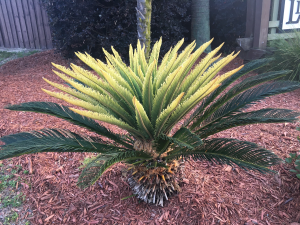The first sign that something is going wrong in a plant is often a loss of the color green. When a sago is forming all new yellow leaves it is a matter of concern. Typically, this a common nutritional deficiency – manganese. Sandy soils of the Panhandle have a hard time retaining nutrients. Manganese and other micronutrient availability is highly influenced by soil pH. Being an essential plant nutrient, manganese is critical to growth. More specifically, it is the base of the metalloenzyme cluster of the oxygen evolving complex (OEC) in photosystem II (PSII). I hope that means more to you than it does me. Basically, manganese is part of the photosynthetic activity and since it isn’t very mobile in the plant, the new growth of sagos turns yellow.
If the nutrient deficiency isn’t corrected, the newly-formed leaves will become deformed and turn brown. In a sago this is referred to as “frizzle-top”. Many people believe the plant has a disease when they see the symptoms and may apply fungicides to no avail. Keep in mind the discoloration of the affected leaves cannot be reversed. However, manganese replacement in the soil will enable the sago to form normal leaves with the next growth phase. Damaged fronds can be removed later to improve the appearance of the sago over time.
Begin this process by determining the soil pH through a soil test. Your local Extension office can help you obtain lab submission forms and explain the collection procedure. Manganese is most available for uptake by sagos when the soil pH is between 5.5 and 6.5. If the pH is above 6.5, larger amounts of manganese will have to be present before the plant can utilize it. When the soil pH is below 5.5 the nutrient is quickly leached out of the soil during rain events.
To correct a manganese deficiency the sago plant will need to receive manganese sulfate. The product is readily available at local nurseries, garden centers and building supply stores. The amount needed for each plant will vary with the size of the sago and the existing soil pH. Sagos growing in sandy, acidic soil will require less manganese sulfate than those in high pH soils. Refer to the package label for application rates.
- Watch for “Melting Grass” - February 19, 2025
- Palms Can Suffer in the Cold - January 30, 2025
- Camellia Care - January 9, 2025

